
Cercosaura is a genus of lizards in the family Gymnophthalmidae. The genus is endemic to South America.
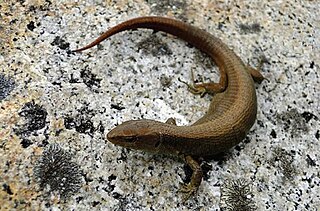
Euspondylus is a genus of lizards in the family Gymnophthalmidae.

Neusticurus is a genus of gymnophthalmid lizards endemic to northern South America. They are often found near streams and are semi-aquatic. Some species formerly included in this genus are now placed in Potamites, which also are semi-aquatic inhabitants of South America.
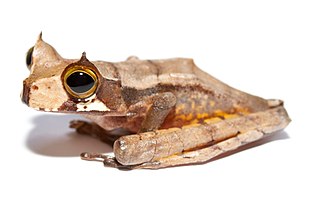
Gastrotheca is a genus of frogs in the family Hemiphractidae. They are found in Central America south of Costa Rica and in South America. Most species occur in the American Cordillera from southern Costa Rica to north-western Argentina. This genus makes up the bulk of marsupial frog diversity; formerly it was placed in the "Leptodactylidae" assemblage.

Phrynopus is a genus of frogs of the family Strabomantidae. Their common name is Andes frogs. They are endemic to Peru and inhabit the upper humid montane forest and supra-treeline grassland in the Cordillera Oriental, with one record from the Peruvian Cordillera Occidental.

Oreobates is a genus of frogs in the family Strabomantidae. Most species were formerly in the genus Ischnocnema, but were moved to this revalidated genus following a 2006 revision. Its sister taxon is Lynchius.
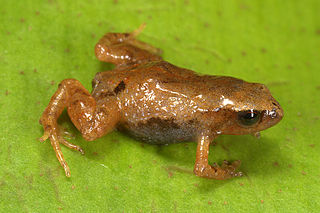
The Strabomantidae, sometimes called cloud forest landfrogs, are a family of frogs native to South America. These frogs lack a free-living larval stage and hatch directly into miniature "froglets". This family includes Pristimantis, the most speciose genus of any vertebrate. Based on molecular dating, the Holoadeninae in particular appears to have originated in the Eocene. The Oligocene-Miocene transition was also found to be important to their biogeographical history. However, the lack of Holoadeninae fossils and limited nucleotide data ambiguates the results, by the authors' admission.
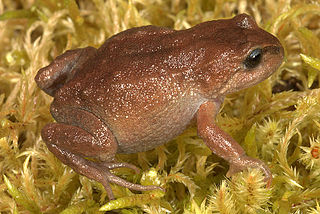
Bryophryne is a genus of frogs in the family Strabomantidae. These frogs are endemic to south-eastern Peru in the Cusco Region, with an undescribed species from the Puno Region. Their range is separated from that of Phrynopus by the Apurímac River valley.
Proctoporus xestus, or the river teiid, is a species of lizard in the family Gymnophthalmidae. The species is endemic to South America.

Potamites is a genus of lizards in the family Gymnophthalmidae. The genus is restricted to northern South America and southern Central America. They are semiaquatic and found near streams.
Petracola is a genus of lizards in the family Gymnophthalmidae. The genus is endemic to Peru.
Selvasaura is a genus of the lizard family Gymnophthalmidae. The genus contains three species.
Andinosaura petrorum is a species of lizard in the family Gymnophthalmidae. The species is endemic to Ecuador.
Proctoporus pachyurus, Tschudi's lightbulb lizard, is a species of lizard in the family Gymnophthalmidae. It is endemic to Peru.
Proctoporus rahmi, Rahm's sun tegu, is a species of lizard in the family Gymnophthalmidae. It is endemic to Peru.

Proctoporus spinalis, Boulenger's sun tegus, is a species of lizard in the family Gymnophthalmidae. It is endemic to Peru.
Riama orcesi is a species of lizard in the family Gymnophthalmidae. The species is endemic to Ecuador.
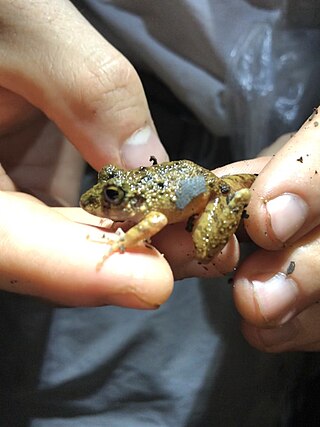
Oreobates amarakaeri, also known as Amarakaeri's big-headed frog is a species of frog in the family Strabomantidae, which is endemic to a small region of south-eastern Peru, in the Manú District, and parts of the Puno Region. The frog was first discovered near the Rio Nusinuscato and Rio Mabe rivers in the Andean foothills of the Amarakaeri Communal Reserve, which are tributaries of the Rio Araza. Since then the species has also been found at the Manú Learning Centre and near Bahuaja Sonene National Park, but weren't fully confirmed to be there until 2019 when four specimens were collected at those localities. At the Manú Learning Centre the frog is known to occur mainly in low disturbance and primary forest habitat, but can also be found near streams in more disturbed areas.
Proctoporus optimus is a species of lizard in the family Gymnophthalmidae. It is endemic to Peru, in montane ecosystems.
Microkayla is a genus of frogs in the family Strabomantidae.











